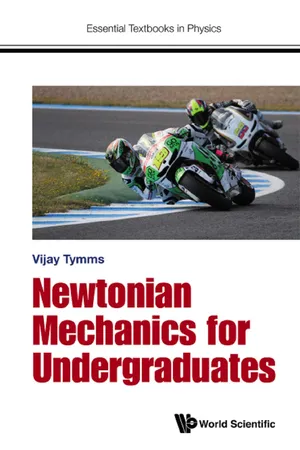
- 268 pages
- English
- ePUB (mobile friendly)
- Available on iOS & Android
Newtonian Mechanics for Undergraduates
About this book
Newtonian mechanics is a cornerstone topic in physics. Regardless of the path an aspiring physicist takes, an intimate and intuitive understanding of how objects behave within Newton's law of motion is essential.
Yet the transition from high school physics to university level physics can be — and should be — difficult. The aim of this book is to teach Newtonian mechanics suitable for the first two years of university study. Using carefully chosen and detailed examples to expose areas of frequent misunderstanding, the first two thirds of the book introduces material familiar to high school students from the ground up, with a more mature point of view. The final third of the book contains new material, introducing detailed sections on the rotation of rigid objects and providing an insight into subtleties that can be troubling to the first-time learner. Tabletop physics demonstrations are suggested to assist in understanding the worked examples.
As a teacher and lecturer of physics with experience at both high school and university level, Professor Vijay Tymms offers a lucid and sensitive presentation of Newtonian mechanics to help make the step from high school to university as smooth as possible.
Request Inspection Copy
Newtonian mechanics is a cornerstone topic in physics. Regardless of the path an aspiring physicist takes, an intimate and intuitive understanding of how objects behave within Newton's law of motion is essential.
Yet the transition from high school physics to university level physics can be — and should be — difficult. The aim of this book is to teach Newtonian mechanics suitable for the first two years of university study. Using carefully chosen and detailed examples to expose areas of frequent misunderstanding, the first two thirds of the book introduces material familiar to high school students from the ground up, with a more mature point of view. The final third of the book contains new material, introducing detailed sections on the rotation of rigid objects and providing an insight into subtleties that can be troubling to the first-time learner. Tabletop physics demonstrations are suggested to assist in understanding the worked examples.
As a teacher and lecturer of physics with experience at both high school and university level, Professor Vijay Tymms offers a lucid and sensitive presentation of Newtonian mechanics to help make the step from high school to university as smooth as possible.
Request Inspection Copy
Readership: Undergraduate physics students, high school students looking to study physics or applied physics at university level, high school physics teachers and first year undergraduate physics lecturers.
Key Features:
- Focuses on Newtonian mechanics taught at undergraduate level
- Features dedicated sections on toppling, rolling and sliding that are more detailed than most mechanics textbooks
Frequently asked questions
- Essential is ideal for learners and professionals who enjoy exploring a wide range of subjects. Access the Essential Library with 800,000+ trusted titles and best-sellers across business, personal growth, and the humanities. Includes unlimited reading time and Standard Read Aloud voice.
- Complete: Perfect for advanced learners and researchers needing full, unrestricted access. Unlock 1.4M+ books across hundreds of subjects, including academic and specialized titles. The Complete Plan also includes advanced features like Premium Read Aloud and Research Assistant.
Please note we cannot support devices running on iOS 13 and Android 7 or earlier. Learn more about using the app.
Information
1
Overview
1.1.Introduction
1.2.Why This Book is Needed
1.3.Who Will Benefit From This Book?
1.4.Assumed Prior Knowledge
1.5.Structure and Topics
Feedback for the Author
2
Introductory Concepts
2.1.Quantities, Units, and Coordinate Systems
2.1.1.Scalar and Vector Quantities
| (1) | A magnitude only. These are known as scalar quantities or simply scalars. Examples of scalar quantities are time, mass, energy, power and density. Mathematical operations on scalar quantities are familiar, i.e. they add, subtract, multiply, and divide like normal numbers. Scalar quantities do not usually require any special notation to denote that they are scalars. |
| (2) | A magnitude and a direction. These are known as vector quantities or simply vectors. Examples of vector quantities encountered in classical mechanics are force, acceleration, velocity, momentum and torque. |
2.1.2.When Vectors Will Be Used and What Knowledge Will Be Assumed
2.1.3.Vector Notation in Print and in Handwriting


2.1.4.Knowing When a Quantity is Scalar or Vector
Table of contents
- Cover
- Title
- Copyright
- Contents
- 1. Overview
- 2. Introductory Concepts
- 3. 1D Motion
- 4. Newton’s First and Second Laws of Motion
- 5. Types of Force and Free Body Diagrams
- 6. Newton’s Third Law of Motion
- 7. Linear Momentum
- 8. Work, Energy and Power
- 9. Potential Energy
- 10. Collisions and Rockets
- 11. Motion on a Curved Path
- 12. Simple Harmonic Motion
- 13. Gravitation
- 14. Rotational Analogues
- 15. Equilibrium and Balance
- 16. Unbalanced Objects
- 17. Rolling and Sliding
- 18. Angular Momentum
- 19. Angular Momentum, Gyroscopes, and Precession
- Bibliography
- Index